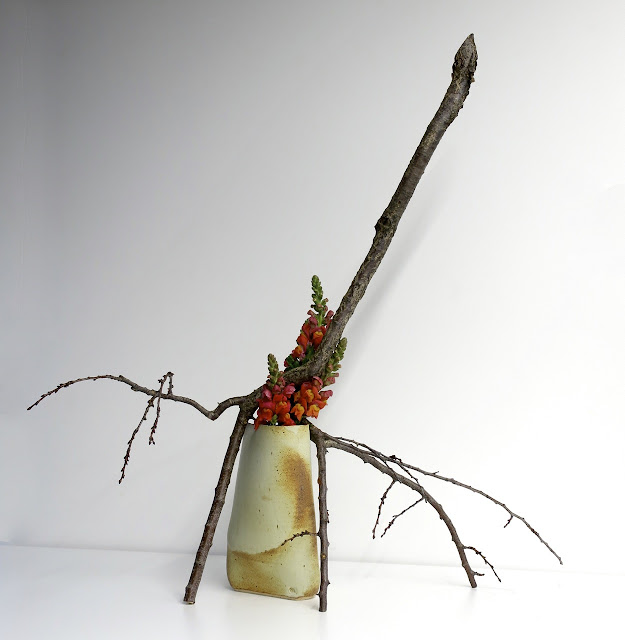The highly variable spring weather has continued with warm sunny breaks followed by rain and occasional hail. A few days ago we were threatened with a cold front bringing more rain...
...so I decided to take a photo of this lovely camellia, Kamo Hon Ami, before it was damaged. It is a new addition to the garden; and I have learnt from 'The Magic of Camellias' (Norman Sparnon and E. G. Waterhouse) that this flower was named after a grandson of the tea master Sen no Rikyu.
The soil in our garden is totally unsuited to growing camellias, being rather alkaline. The soil is also hydrophobic, so that water runs off the surface rather than penetrating and being held in the soil. I have been assured by my ikebana friends that camellias can do well in pots! I certainly hope so.
Last week I showed photos of arrangements incorporating narcissus, by my Melbourne students. Among the large number of my photos I managed to miss this one by Marcia. She had made a main subject of two lichen- encrusted branches balanced by a small mass of narcissus enclosed in a 'cage' of their leaves.
In Geelong, my advanced students made arrangements in clear glass vessels using leaves only.
Helen M cleverly suspended a small sprig with fine yellow leaves from two dietes leaves balanced across the top of the vase.
She also curved two dietes leaves and a succulent rosette inside a glass bowl, proving that minimal material is needed in a glass vessel with a spherical curve.
Maureen was interested in showing the beautiful curve and repeated lines in this cycad frond, to which she added a curled yucca leaf.
In this second arrangement Maureen has suspended a mass of small orangey, shiny leafed material that floats in an empty glass vase.
Ellie also used some cycad fronds and a single leaf of a prayer plant, maranta leuconeura, in three glass vessels. She wired two cycad fronds together and has arranged them vertically on the edge of a glass vase so that they float.
On Monday last week I attended a Victorian Sogetsu Branch workshop led by Emerald Leung. She had set the topic of making an ikebana arrangement that accentuates line, mass and colour, using two kinds of materials only. Branches and leaves could be used but not flowers.
How fortunate was I to notice these brightly coloured leaves of Eucalyptus Lehmanii, some of which were growing outside the bathroom window. They were ideal for making a colourful mass. The autumn colouring at this time of year is the result of insect damage. I have used Pomaderris paniculosa from the garden for the lines. To emphasise the lines I cut them all to one length. I also stripped the leaves off, except for a small line of leaves on a single branchlet.
When I got home I re-worked the ikebana, removing the lowest of the lines and bringing it up to a more horizontal position. The Bizen style vase is by the Australian ceramic artist Ian Jones.
Greetings from Christopher
25th August 2019
Click here for photos from the Sogetsu Branch workshop.


































